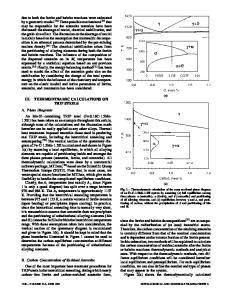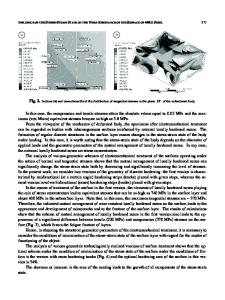The influence of the stress state on the plasticity of transformation induced plasticity-aided steel
- PDF / 16,743,596 Bytes
- 9 Pages / 612 x 792 pts (letter) Page_size
- 62 Downloads / 399 Views
NTRODUCTION
THE high ductility of transformation induced plasticity (TRIP)-aided steel, containing small amounts of retained austenite in the microstructure, results from the transformation of metastable austenite to martensite under straining.[1,2] The volume expansion that accompanies the transformation and the replacement of the retained austenite by the much harder martensitic phase increases the strain-hardening rate and delays the strain localization. The effective prevention of necking leads to a significant increase of the uniform elongation. In recent years, intercritically annealed, lowalloy TRIP-aided steels alloyed with Mn, Si, and Al have been developed. The carbon enrichment of the austenite during the isothermal bainitic transformation is very effective due to the suppression of the cementite precipitation by the Si or Al additions. This provides significant amounts of retained austenite in the final microstructure.[3–6] The formability of a material can be evaluated by means of uniform elongation as measured during a standardized tensile test.[6–9] The stress path and strain path corresponding to industrial sheet forming processes are essentially different from the well-defined strain path and uniaxial stress of the tensile test. Other approaches for technological formability estimation are usually needed. The purpose of the present article is to study of the influence of the stress state on the plastic deformation of TRIP-aided steel and to explain the observed behavior by the analysis of the microstructures. It is well known that the plasticity of the material is I.YU. PYSHMINTSEV, Laboratory for Iron and Steelmaking, Ghent University, Professor, is on leave from the Urals State Technical University, Ekaterinburg, Russia, M. De MEYER, Graduate Student, and B.C. De COOMAN, Professor, are with the Laboratory for Iron and Steelmaking, Ghent University, B-9052 Ghent, Belgium. R.A. SAVRAY, Graduate Student, and V.P. SHVEYKIN, Professor, are with Urals State Technical University, Ekaterinburg, 620002, Russia. M. VERMEULEN is with OCAS NV, B-9060 Zelzate, Belgium. Manuscript submitted May 10, 2001. METALLURGICAL AND MATERIALS TRANSACTIONS A
increased by deformation under high hydrostatic pressure, as this results in a low ratio of normal to shear stresses.[10,11] Technologically, this effect could be exploited by means of an appropriate tube and sheet hydroforming tool design by allowing the direct application of a high hydrostatic pressure. In fact, the results of the present work suggest that using some of the current hydroforming tool designs retrofitted with a backpressure could provide a significantly improved stress state during deformation. The fact that hydrostatic pressure has a fundamental influence on the austenite to martensite transformation is particularly significant for low-alloy TRIP-aided steel. The effect of austenite stabilization by a high hydrostatic pressure has been reported for different steel grades containing austenite, such as high-alloy TRIP steel and austenitic stainless ste
Data Loading...











